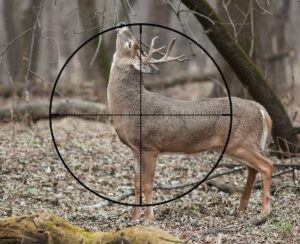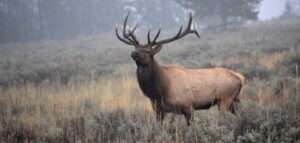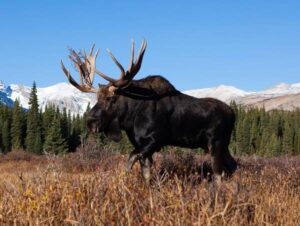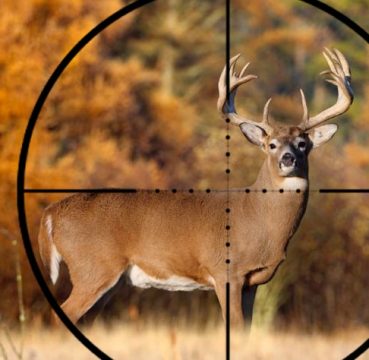When hunting for deer, or for elk or moose or any other game animal, your top priority (besides actually locating your game in the first place) should be to make an ethical shot that brings down the animal with only one hit. There are few things worse when hunting than taking a shot, only for the animal to be hit in a non-vital region and take off running. Not only does it mean that you now have a lot of tracking and more walking to do, it’s also not ethical towards the animal to merely wound it and let it bleed out later.
Table Of Contents
Choosing Your Weapon
First thing’s first: before you go hunting, you need to make sure that you are using a gun and caliber of sufficient power to bring down the animal ethically on your first shot.
The .30-30 Winchester caliber has arguably brought down more deer in North America than any other cartridge in history, and will be more than sufficient to bring down a whitetail or mule deer on your next hunt (as well as any calibers that are of equal or greater power, of course).
For elk, .30-30 Winchester is a bit too light to bring down he animal ethically with one shot, and the general minimum accepted caliber for elk is considered to be the .270 Winchester or an equal caliber. Any rifle chambered in .270 Winchester or above will be sufficient for bringing an elk down.
For moose, being much heavier and bulkier than either elk and especially deer, the minimum caliber you should use should be .308 Winchester, but some hunters would argue that an even larger caliber such as .30-06 Springfield or .300 Winchester Magnum would be preferable as they have more power in order to penetrate through the thick hide and flesh.
Besides the specific caliber you are using, you also should use soft point ammo for hunting, which will expand more upon impact and cause more damage. Full metal jacket ammunition is cheaper and great for target practice, but it’s not preferable for hunting purposes.
Deer
There are several regions to shoot a deer and bring it down with only a single hit.
The first is the brain, which is almost certain to bring down the deer within seconds. This is also arguably the most humane way to kill a deer, because it immediately takes out all of its essential functions. All you need to do is draw two lines from the right eye to the left ear and again from the left eye to the right ear. The center is where you should place your shot.

The only bad thing about shooting a deer in the brain is that the target area is obviously very small, so the chances of you actually making the hit are more limited. After all, a deer’s head is only around three inches, so shooting it with precision from a hundred yards or more will not be guaranteed even with a high quality scope.
An area of the deer that will be much easier to hit is its broadside.
But rather than just shooting a deer anywhere in its side, you should aim for the heart and lung region, which is the circulatory system’s center.
This area has an approximate four inch radius, and is the site of numerous blood vessels and arteries that surround the heart and lungs. If these arteries are hit, there will be significantly blood loss, which will cause the deer to go unconscious after only a few seconds if it isn’t killed outright.
But as with the head, the target area of the lung and heart region is very small at only four inches, so there’s no guarantee that you can make the shot accurately from a long distance.
An area in the side that will be easier to hit is the upper should region. The objective is to hit the deer’s scapula (shoulder blades), which will paralyze it instantly and should outright kill the deer right away as well. A the very least, a shot through the scapula will incapacitate the deer and bring it down right away; if it’s still alive when you walk up to it, you can then deliver the coup de grace to the animal with a shot behind the ear when you approach it.
Another region where you can shoot a deer and bring it down with a single shot, even though it’s commonly overlooked by hunters, is the neck region. After all, the neck connects the brain with the heart and lungs, so it essentially serves as the connection between the two most vital regions to shoot a deer.
That being said, shooting a deer in the neck is only guaranteed to bring the animal down with one shot if the bullet can manage to disconnect the heart and lungs from the brain, or if it can break the spinal cord, which will have the same effect as shooting the deer in the scapula.
Just remember that just because you shoot a deer in the neck means that you’re going to bring down the animal, because you have to either hit the spinal cord or cut off the supply of blood to the brain. If you fail to do either of those, chances are good the deer will take off running and you’ll have to take off after it.
Elk
Generally speaking, the rules for ethically shooting an elk are the same as they are for a deer. This means that hitting the elk in the brain, spinal cord, or lungs/heart region will bring it down.

Just take note that with an elk, you should not take head or neck shots if you are bow hunting. Instead, aim for the chest cavity in the hope that you’ll score a double lung shot.
The primary challenge with shooting an elk over a deer is that elk are much larger and bulkier.
This is why it’s very important that your shot manages to deal significant damage to the vital region instead of the bullet being stopped in the elk’s flesh.
For example, if a deer is quartering away from you, if you take a shot at the shoulder region the bullet still has a good chance of tearing through the lungs or heart. With elk, however, it’s possible for the bullet to be stopped in the flesh or bone. That’s why with elk, it’s preferable to wait for a broadside shot if at all possible. If the elk is facing you directly, you should aim for the chest region right below the neck.
Moose
Moose are the largest members of the deer family worldwide, but believe it or not, they are not as tough as an elk pound-for-pound.

Nonetheless, moose are still significantly broader and heavier, so you still will want to place your shots carefully. The best place to shoot a moose and bring it down with one shot will be to aim for he upper half of the neck that drops down; hitting the moose here will break the spinal cord and bring down the animal instantly.
The spine is a small target, so you can also aim for an upper shoulder shot.
You will sacrifice some meat, but shooting the moose in the upper shoulder will break at least one shoulder and also likely hit the heart.
Conclusion
In conclusion, the rules for shooting a deer, elk, or moose are largely the same: the best regions to aim will be the brain, upper shoulder, heart/lung region, or in the neck if you can either severe the spinal cord or cut off the supply of blood to the brain.
Remember to get plenty of practice in at the range by setting up life size deer or elk targets and then aiming for those vital regions. Hopefully, when you actually do find your game on the hunt you’ll ethically bring it down with only a single shot fired.











